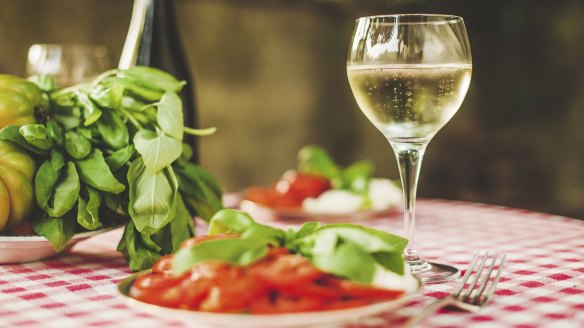Top 10 proseccos from near and far

Prosecco, despite its sparkling nature, is consumed these days by dark thoughts, mulling over questions of legality and cultural pilfering.
It's all been a bit bewildering for the increasingly popular bubbly since the Italians indicated they wanted total ownership and control over use of the prosecco name. Anyone else using it – and that includes Australian winemakers – well, they're imposters.
Recently the director of the Prosecco DOC Consortium, Stefano Zanette, went on the record to call out the Australians. Late last year he told international drinks magazine The Drinks Business that imitators were jumping on the prosecco bandwagon, and that "imposters" marketing themselves as prosecco were being produced "all over the world, from Australia to Brazil".
He then implied there had been misleading marketing. "Why isn't Australian prosecco sold with other Australian wines?
"Why is it put on the shelf with Italian wines? Why is it that very often, in the labelling of the product, reference is made to Italy or the Italian-ness of the producers?"
It was a spirited defence of a wine that the Italians see as their own, and one that is surging in sales across the world. Prosecco is even biting into the champagne market in Britain.
But the Italians are wrong.
The prosecco grape originates from Italy's hilly north-east, no doubt about that. It was always thus until its simple charm was recognised and the little grape began to travel.
That's when the Italians got worried. In 2009 they changed the name of the prosecco grape to glera, which is an accepted synonym. Then they promoted "Prosecco" as the name of the region, which should have automatically protected it from use in this country under the EU-Australia Wine Trade Agreement.
But the Australians remain unmoved and they have the law on their side: It comes down to a matter of prior use. In this country, "prosecco" has been accepted as the name of the grape variety, an allowable synonym, since long before the Italians changed it. For that we can thank the first Australian to plant the grape in the 1990s – Otto Dal Zotto of Dal Zotto Wines in the King Valley – who did so because he loved it and it reminded him of where he was born, Valdobbiadene in the Veneto region. It just happens to be home to prosecco, too.
So, prosecco it is. Let's not hear any more about imposters and copycats.
Our market – 14 per cent of Australian drinkers now enjoy prosecco compared with just 5 per cent in 2011 – is proving big enough for both the Italians and Australians.
Indeed, the two styles complement each other: the slightly more fruit-forward Australians sit well with the more reserved Italians.
Celebrare la differenza!
The Italians: five of the best
1. Bellussi di Valdobbiadene Prosecco DOC ($25)
If prosecco can be vibrant and fun, it can also be a sedate, subtle beauty. Everything about this wine is turned down: the bubble is finer, the presence of a lilting herbal scent entices rather than announces, flavours of apple, nougat meld nicely, going, going long.
2. Il Colle 46˚Parallelo Conegliano Extra Dry DOCG ($29)
A non-vintage showing some interesting development, Il Colle is quieter and smoother than most. A distinctive lemon, lime and bitters aroma reveals a herbal edge that becomes more pronounced on the palate, closing with a baked bread yeastiness.
3. Mionetto Prosecco Cartizze DOC ($50)
One of the more expensive proseccos going, which made a corked Mionetto especially disappointing. On second purchase things looked brighter with green apple, lemon curd aromas and flavours enhanced by a light savouriness.
4. Porta Dante Prosecco Extra Dry ($24)
A super juicy, grapey prosecco that emphasises the dried herbal, savoury edginess of the grape. It opens on the mouth with the prettiest honeysuckle and lasts long.
5. Salatin Prosecco Treviso Extra Dry ($23)
As we drink more prosecco we attract more and more of the good stuff from Italy. Salatin offers a winemaking lesson in structure and depth of flavour with generous texture. Everything fits snugly into this tight package, from the lantana, citrus blossom scent through to a sweet grapefruit delicacy that smacks clean and fresh.
The Australians: five of the best
1. Dal Zotto 2014 Pucino Prosecco ($23)
From the pioneers of prosecco in Australia comes one of the leading styles highlighting the grape's celebrated joie de vivre. Imagine the scent of lemon gelato, freshly squeezed meyer lemon and ruby grapefruit with a soft but bright acidity.
2. Freeman 2015 Prosecco ($23)
Sensitive handling highlights a strong, natural acid drive, the bones around which to build a wine with a dusty lemon sherbet zing. A touch savoury as well, which adds an attractive dimension.
3. La Prova 2015 Prosecco ($25)
From Adelaide Hills winemaker Sam Scott comes yet another scintillating Italian grape interpretation, this time using King Valley fruit. Cut herbs to start followed by a tight palate of lemon rind, almond meal, sugared almond confection. Super dry.
4. Pizzini 2014 Prosecco ($21)
From the Australian home of prosecco, the King Valley, comes a prosecco with another Italian-Oz connection, combining the scent and flavours of garden herbs with a pleasant herbal and citrus thread running go to whoa.
5. Redbank 2015 Prosecco ($20)
Sourced from prosecco central – the King Valley – this charming bubbly doesn't pretend to be anything other than delicious, playing up to the grape's strong suits: citrus, lemon rind savouriness, confection.
Prosecco will feature at this month's Melbourne Food and Wine Festival. The prosecco producers of the King Valley bring their well-travelled Prosecco Road to the Southgate Promenade from Friday, March 4 (starting 5pm) through to Saturday, March 5 and Sunday, March 6 (starting noon). Entry is free. No bookings are required.